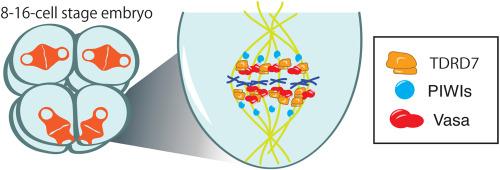Germline factors, TDRD and Piwi, colocalize with Vasa on the mitotic apparatus during the embryogenesis of the sea urchin
IF 2.1
3区 生物学
Q2 DEVELOPMENTAL BIOLOGY
引用次数: 0
Abstract
Germline factors are thought to function exclusively in the germline, providing the unique characteristics of germ cells. However, recent studies suggest that some of these factors may also be expressed and function outside the germline. One such example includes Vasa, a DEAD-box RNA helicase that appears to control localized translation on the spindle, facilitating efficient protein synthesis during embryogenesis of the sea urchin. However, it remains unclear if other germline factors are also involved in this process. In this study, we investigated the localization dynamics of Vasa's partners in the germline, such as Tudor-domain-containing proteins (TDRDs) and P-element-induced wimpy testis proteins (Piwis). Among TDRDs tested in this study, we found that TDRD7 is enriched on the spindle and forms granules with Vasa during early embryogenesis. Vasa and TDRD7 recruited each other when the expression of either was forced at the membrane, suggesting their interaction with each other. TDRD7 mutants lacking the N-terminal eLOTUS domain or the central intrinsically disordered region exhibited reduced granule formation, which also compromised their recruitment to Vasa. In contrast, PiwiL1/2 and PiwiL3 showed enrichment at the perinuclear region and the spindle, yet were never recruited to Vasa or TDRD7 when either was expressed at the membrane. These results suggest that a group of germline factors is present and may dynamically interact with each other on the spindle, contributing to somatic cell regulation in the sea urchin embryo.

在海胆胚胎发生过程中,种系因子TDRD和PIWI与Vasa共定位于有丝分裂器上。
生殖系因子被认为只在生殖系中起作用,提供了生殖细胞的独特特征。然而,最近的研究表明,其中一些因素也可能在种系外表达和起作用。一个这样的例子包括Vasa,一种DEAD-box RNA解旋酶,它似乎控制纺锤体上的局部翻译,促进海胆胚胎发生过程中有效的蛋白质合成。然而,目前尚不清楚其他生殖细胞因素是否也参与了这一过程。在这项研究中,我们研究了Vasa的伴侣在种系中的定位动态,如都铎结构域蛋白(TDRDs)和p元素诱导的睾丸蛋白(Piwis)。在本研究检测的TDRDs中,我们发现TDRD7富集于纺锤体上,并在胚胎发生早期与Vasa形成颗粒。当Vasa和TDRD7在细胞膜上被迫表达时,它们相互招募,表明它们之间存在相互作用。缺乏n端eLOTUS结构域或中心内在无序区的TDRD7突变体表现出颗粒形成减少,这也损害了它们对Vasa的募集。相比之下,PiwiL1/2和PiwiL3在核周区和纺锤体富集,但当膜上表达Vasa或TDRD7时,它们从未被招募到。这些结果表明,一组生殖细胞因子可能在纺锤体上动态相互作用,参与海胆胚胎的体细胞调节。
本文章由计算机程序翻译,如有差异,请以英文原文为准。
求助全文
约1分钟内获得全文
求助全文
来源期刊

Developmental biology
生物-发育生物学
CiteScore
5.30
自引率
3.70%
发文量
182
审稿时长
1.5 months
期刊介绍:
Developmental Biology (DB) publishes original research on mechanisms of development, differentiation, and growth in animals and plants at the molecular, cellular, genetic and evolutionary levels. Areas of particular emphasis include transcriptional control mechanisms, embryonic patterning, cell-cell interactions, growth factors and signal transduction, and regulatory hierarchies in developing plants and animals.
 求助内容:
求助内容: 应助结果提醒方式:
应助结果提醒方式:


